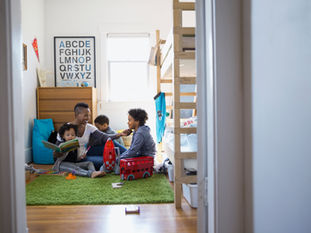
Communication: Deepening Connections Through Thoughtful Words and Presence
Apr 4
3 min read
0
4
0

Communication is more than the exchange of words—it’s the foundation of how we build trust, cultivate understanding, and nurture deeper connections with ourselves, our children, and our communities. Yet, meaningful communication requires more than just speaking or listening. It calls for awareness, intention, and a commitment to creating safe spaces where honesty can flourish.
Whether we’re navigating inner dialogue, connecting with our children, or fostering friendships and community relationships, how we communicate shapes the quality of our connections. In this post, we’ll explore ways to practice mindful communication that strengthens relationships and nurtures trust.

The Connected Path: Communicating with Yourself
Communication begins internally. The way we speak to ourselves sets the tone for how we show up in the world. Self-talk—whether encouraging or critical—becomes the narrative that shapes our confidence, resilience, and emotional well-being. Being intentional about how we communicate with ourselves requires self-compassion and a willingness to challenge inner narratives that no longer serve us.
Practice 1: Notice Your Inner Dialogue: Pay attention to the words and tone you use when talking to yourself. Are you speaking with kindness or criticism? Pause and reframe harsh self-talk into affirming, supportive statements.
Practice 2: Ask Yourself Curious Questions: Develop a habit of asking reflective questions like, “What do I need right now?” or “How can I support myself in this moment?” This practice nurtures self-awareness and aligns your actions with your values.
Practice 3: Write to Your Future Self: Journaling can be a powerful form of self-communication. Try writing letters of encouragement, reflection, or guidance to your future self. This helps build trust and compassion as you navigate life’s journey.

Nurturing Connections: Communicating with Your Child
Effective communication with children isn’t just about giving instructions—it’s about creating space for connection, understanding, and emotional safety. Children thrive when they feel heard, valued, and understood. Building this kind of trust requires active listening, empathy, and a willingness to engage with their perspectives, no matter how different they may be from our own.
Practice 1: Pause and Listen Fully: Give your child your full attention when they speak. Put aside distractions and be present. Reflect their words back to them to ensure they feel heard and validated.
Practice 2: Use Open-Ended Questions: Invite conversation by asking questions that encourage your child to express their feelings and thoughts. For example, “What was the best part of your day?” or “How did that make you feel?”
Practice 3: Model Emotional Language: Help your child develop emotional intelligence by naming and expressing your own feelings in age-appropriate ways. Saying, “I’m feeling a little overwhelmed right now” teaches them that emotions are normal and safe to express.

Heart-Centered Community: Communicating in Relationships and Groups
Healthy communication is essential for thriving communities and relationships. It fosters understanding, prevents misunderstandings, and creates environments where people feel valued and heard. Whether leading a group or participating in a community, cultivating open and respectful communication builds a foundation of trust and belonging.
Practice 1: Be Clear and Honest About Expectations: Whether you’re setting boundaries or making requests, clarity prevents confusion and strengthens trust. State your needs directly, while remaining open to others’ perspectives.
Practice 2: Embrace Curiosity and Active Listening: Approach conversations with the intention of understanding, not just responding. Reflect on what others share before offering your perspective, and ask clarifying questions to deepen understanding.
Practice 3: Name and Address Misunderstandings Early: Avoiding discomfort can lead to unspoken tensions. When misunderstandings arise, address them with care and honesty. Naming what’s happening creates space for repair and growth.
Communication is a practice that grows stronger with intention and awareness. Whether we’re nurturing a kind inner dialogue, creating emotional safety for our children, or strengthening bonds within our communities, our words hold the power to build or break trust.
What aspect of communication feels most alive for you right now? I’d love to hear your thoughts and experiences in the comments. And if you’d like to continue exploring ways to cultivate meaningful connections, be sure to subscribe for future posts.
Let’s continue this journey of authentic, heart-centered communication together.💜🌻





